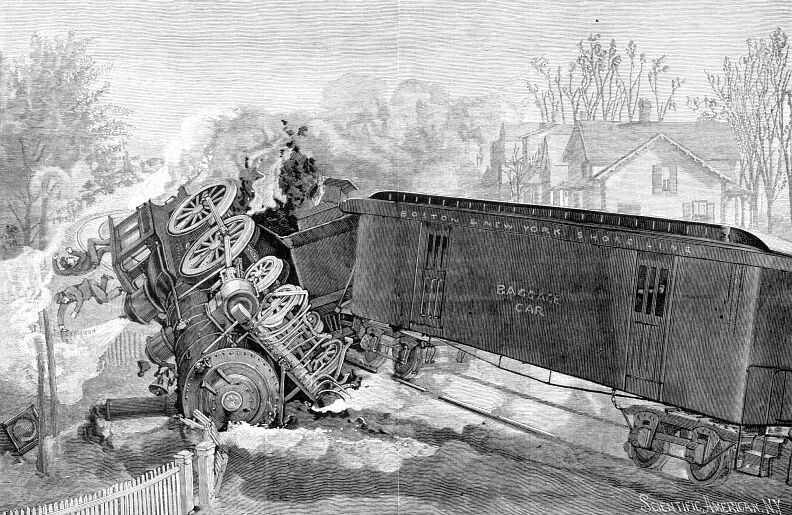A REMARKABLE RAILROAD ACCIDENT.
Scientific American—May 30, 1891
A noteworthy instance of the very singular manner in which
railway accidents sometimes take place, and where the escape from
great loss of life seems little less than miraculous, was afforded
by the wreck on the Shore Line Railroad, a little east of New
Haven, on April 18, which forms the subject of the accompanying
illustration.
The east bound Boston and New York Express left New Haven at
3:05 P. M. The train consisted of the locomotive, one baggage
car, and four passenger cars. It had just passed over the long
Quinnipiac River bridge, and was rounding a curve, when the flange
of the left hand forward truck wheel of the locomotive broke,
and a portion of the wheel nearly eighteen inches long flew off.
The train had been going at the rate of only about twelve or fifteen
miles an hour over the bridge, and the engineer had just opened
the throttle for full speed when the accident happened. With the
breaking of the flange, the wheel left the track on the curve,
the other truck wheels and the driving wheels also being derailed
and bumping along on the ties for some distance, as the locomotive
was pushed ahead by the impetus of the train, the locomotive being
finally turned completely around and thrown to one side of the
track, landing in a partially crosswise position over a shallow
ditch or gully. The engineer had been leaning from his cab window,
and he was pitched forward into the ditch, the locomotive falling
over him, but not upon him, so that he was enabled with a little
assistance to crawl out, not having received any serious injuries.
The fireman likewise went over the cab and was thrown out into
the mud and water of the ditch. The engineer saw the truck wheel
strike the ties, and instantly put on the air brakes and blew
the whistle.

Just beside the track, at the place where the accident happened, is a private
residence, from which the manner of its occurrence was noted by eyewitnesses.
It is said that the momentum of the train appeared to lift the rear end of the
locomotive, so that the frame of the cow catcher caught in some heavy planking
at the side of the track, when the locomotive was made to turn almost a complete
somersault before it landed in the ditch. The tender, which had been drawn from
the rails by the engine, was finally swung around and landed in the ditch to
the rear of The locomotive, its forward end also pointing in a direction opposite
to that in which it had been going. The connecting link between the tender and
baggage car was broken, and the latter was pushed into an embankment on the
opposite side of the track, when all further progress of the train was stopped,
the first passenger coach, which had not left the track, being brought to a
standstill immediately opposite the derailed and overturned locomotive, which
but a moment before was pulling the train.
The damage to the locomotive was by no means as great as might
have been expected, although the cab was broken to pieces, the
cow catcher broken and its rods twisted out of shape, and the
iron sheathing punctured and ripped in many places. The locomotive
was built in 1873, and was to have been taken to the repair shops
the next week. The engineer testifies to having tried the wheel
with a hammer before the train left New Haven, but a few minutes
previous to the accident, and that he found it good and sound.
It would have been a little remarkable for the truck wheel to
have left the track in such a manner had it not been that the
engine was on a curve, and the comparatively slow rate at which
the train was moving tended to minimize the danger. As it was,
there were not a few of the passengers who felt profoundly thankful
that the accident had not happened some four hundred feet further
back, when the entire train might have been precipitated from
the high bridge into the Quinnipiac River.
Railroad Accidents
| Contents Page
|







